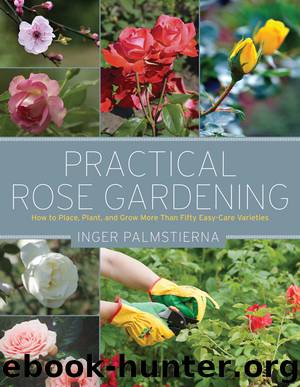Practical Rose Gardening: How to Place, Plant, and Grow More Than Fifty Easy-Care Varieties by Inger Palmstierna

Author:Inger Palmstierna
Format: epub
Publisher: Perseus Books, LLC
Published: 2014-12-31T16:00:00+00:00
Modern roses in an old-world styled setting. Stones cover the ground around the roses, which are surrounded by a small brick ledge that is covered in plants. It looks just like a small hedge.
Cover material that requires fertilizer
Another option is to cover the ground with a layer of material thick enough that weeds can’t penetrate it. Groundcover bark and wood chips are commonly used for this because they contain weed inhibitors. Covering the ground with bark mulch and wood chips does require extra care, though; since they’re both natural products, they will eventually break down and molder. A lot of nutrients are needed for this decay to take place, and these are leached from the soil. None, or at least very little, nutrition is then left over for the roses, and if there is competition for nutrition, the bark mulch will always come out ahead. You will therefore need to fertilize your roses regularly, and in extra quantities. The more the mulch bark disintegrates, the more like earth it becomes. If you decide to forgo using a fabric cover, you’ll need to set down a thick layer of bark mulch, which will cause the roses to get a later start in spring. If you do use fabric underneath the layer of bark mulch, then the layer needn’t be so thick, but then you’ll still need to apply extra fertilizer.
Cacao mulch has only recently been made available in Sweden. This mulch breaks down in the same way as wood chips. It’s a byproduct of processing cacao beans, and consists of the thin shells from the beans. The shells contain substances that make the material bind into a hard crust. It stays put even on a slope, and doesn’t blow away when dried out. Cacao mulch darkens with age, and ends up looking like soil—very dark brown in color. You can add cacao mulch in the fall to protect the plants from the winter cold, but even cacao mulch needs extra fertilizing.
Download
This site does not store any files on its server. We only index and link to content provided by other sites. Please contact the content providers to delete copyright contents if any and email us, we'll remove relevant links or contents immediately.
| Annuals | Bulbs |
| Flower Arranging | Orchids |
| Perennials | Roses |
Turbulence by E. J. Noyes(7920)
The Thirst by Nesbo Jo(6809)
Gerald's Game by Stephen King(4556)
Be in a Treehouse by Pete Nelson(3924)
Marijuana Grower's Handbook by Ed Rosenthal(3606)
The Sprouting Book by Ann Wigmore(3530)
The Red Files by Lee Winter(3357)
The Remains of the Day by Kazuo Ishiguro(3280)
Sharp Objects: A Novel by Gillian Flynn(2940)
Christian (The Protectors Book 1) by L. Ann Marie(2644)
Organic Mushroom Farming and Mycoremediation by Tradd Cotter(2616)
The Culinary Herbal by Susan Belsinger(2420)
Stone Building by Kevin Gardner(2336)
The Starter Garden Handbook by Alice Mary Alvrez(2271)
Lilac Girls by Martha Hall Kelly(2243)
The Unlikely Pilgrimage of Harold Fry by Rachel Joyce(2202)
The Lean Farm Guide to Growing Vegetables: More In-Depth Lean Techniques for Efficient Organic Production by Ben Hartman(2087)
Urban Farming by Thomas Fox(2054)
Backyard Woodland by Josh VanBrakle(1879)
